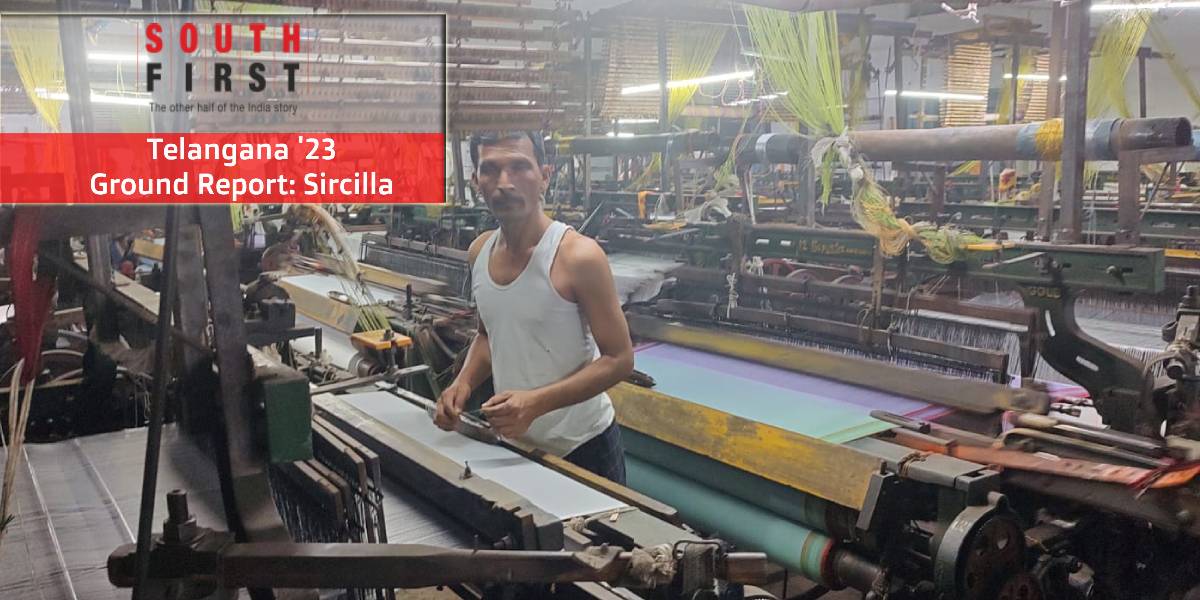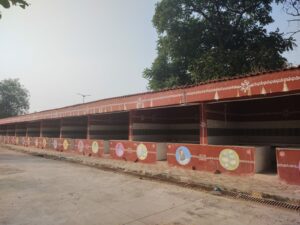Several voters praised sitting MLA KT Rama Rao's initiatives and believed that the Opposition fielding a candidate was a mere formality.

As many as 139 Mutually Aided Cooperative Societies (MACs) and around 142 Small Scale Industries (SSIs) are situated in Sircilla. (Ajay Tomar/South First)
With the Telangana Assembly elections 2023 just days away, South First is bringing you ground reports from key constituencies. This series brings you voices from the ground, the mood of the voters, and issues that matter — as well as those that don’t.
“There are many other towns that have not been developed, but ours has been. Development reached here because of KTR,” said an elated Sai Kiran, standing beside the Surabhi hotel at Sircilla town’s crossroads.
The 25-year-old software engineer’s friends nodded in agreement.
Sircilla, considered a major textile hub of Telangana, has witnessed at least 300 suicides of weavers and their family members over the past decade or so.
Yet, it has progressed enough to host multiple educational institutes, an apparel park for garment industries, and several eateries. Civic infrastructure has seen an improvement, and there are several development initiatives visible on the ground.
The recent upward trajectory in the weaver’s lives has been possible due to large-scale government intervention in the town’s once-dwindling power-loom industry.
A major chunk of the credit goes to the orders coming for free Bathukamma festival sarees as well as sarees distributed during Christmas and Ramzan.
However, this excitement does not affect N Kanhaiya (61), a weaver at Pavithra Textiles in the town’s Ambika Nagar, a locality where a majority of nearly 30,000 power looms are to be found.
Kanhaiya is one of the estimated 10,000 daily-wage weavers in Sircilla. Most of his ilk are from the Padmashali community, who are traditionally weavers.
As many as 139 Mutually Aided Cooperative Societies (MACs) and around 142 Small Scale Industries (SSIs) are situated there.
For the year 2022-23, the Telangana government reportedly placed an order for the production of nearly five crore metres of fabric for its Bathukamma sarees distribution scheme. Various other government departments also place orders of nine crore metres of fabric worth about ₹500 crore with the MACs and SSIs in the Sircilla power-loom cluster per annum.
However, for a gloomy Kanhaiya, the Bathukamma saree order provides a livelihood for only half of the year.
“The work comes in the fifth month of the year (May) and ends around 10th (October). At this point of the year, we have an abundance of work. The situation is the opposite for the rest of the year when we only have cotton or polyester fabric to produce. It gives less profit. It would be useful if we had work throughout the year. Only then we can run the household expenses and educate our children, properly,” the resident of Rajeev Nagar and the sole earning member of his family of five tells South First.
He then took over the electronic jacquard machine, which his colleague M Venkateshwar (46) was reeling. Both of them, along with one more worker, manage over 50 such machines during their 12-hour shift in the workshop.
During the season, the time they receive orders from the government, they make ₹15,000-16,000 per month, while for the rest of the year, their salary is a mere ₹4,000-5,000.
Meanwhile, Venkateshwar, while sipping a glass of water, points towards a machine and says, “In case of any job, it would be throughout the year, right? So should our work be.”
He hopes the government will start giving Bathukamma sarees orders all over the year — from January to December. “Even if not sarees, some other order should be provided for the rest of the year,” Venkateshwar asserts while speaking to South First.
Vemulla Damodar, 50, a power loom owner said: “For the rest of six months, the government is advising the power loom owners (also known as master weavers) to get work from the private sector. But the profits we make are less from the private sector.”
Reports suggest that Sircilla has seen a transformation over the past nine years. Apart from the sarees, the government also gives orders for the school uniforms and bags for the Chief Minister K Chandrashekar Rao (KCR) Kit.
While expressing happiness over the government stepping in, Damodar now wants the government to take the industry a step further.
“We believe that it is the fourth textile hub after Surat (Gujarat), Bhiwandi, and Sholapur (Maharashtra). But here we need to upgrade the machines to the level of Surat and Bhiwandi, which have advanced technology semi-automatic 4/1 electronic jacquard machines. They have processing units as well, which we do not have here,” he explained while speaking to South First.
Pointing towards cotton fabric, Damodar claims that the present machines are not making a wide variety of sarees.
“The machines that we use now can only produce fabrics of nearly 40 to 50 metres in length. With new machines, the length can go up to 500 to 3,000 metres and we could improve the productivity with more designs,” he quipped.
While noting that setting up a machine costs nearly ₹6 lakh, including four lakh for the assembling of electronic jacquard, the 50-year-old master weaver wants the state government to support the weavers in buying the latest technology.
“If the government bears 70-80 percent of the cost of these machines, which is ₹4-5 lakh, the owners can spend the rest from their pockets,” he believes.
Telangana government also provide subsidies on electricity to the weavers. But Damodar wants them to provide subsidies on par with their Karnataka counterparts.
“Our government provides a subsidy of ₹2 to ₹2.25 per unit while in Karnataka the weavers get a subsidy of ₹1 to ₹1.25 per unit. It would be better if the charges are slashed down for us as well,” a hopeful Damodar says.
Every morning, around 4 to 5 am, farmers from distant villages as well as from Sircilla town come to Rythu Bazaar (integrated farmer’s market) to sell their produce.
S Sandeep (name anonymised to avoid backlash), who comes from Sircilla town is one of them. While he expressed satisfaction that a Rythu Bazar has been started, he pointed out several maintenance issues.
The market, which was inaugurated by IT Minister and sitting MLA from the Sircilla segment, KT Rama Rao in 2020, is three-fourths the size of a football field. was reportedly built at a cost of ₹5.15 crore.
The government on its website boasts that the district Agricultural Market Committee (AMC) has developed infrastructure facilities such as internal roads, godowns, open platforms, covered sheds, proper electricity, and water supply.
However, for Sandeep, all this means nothing when he compares it to Siddipet’s Rythu Bazar (nearly an hour’s drive from Sircilla) — considered one of the best in Telangana.

S Sandeep said there is no electricity and only buttons with empty sockets. When South First verified, the power sockets were empty and there were no ceiling fans, too. (Ajay Tomar/South First)
“It is merely a building as there is no electricity and only buttons with empty sockets. There is no security guard also. There are no proper sheds like Siddipet. We come at 4 am but leave till 11 am whereas in Siddipet they stay the whole day from morning to evening. Cleaning is also done once in a few days,” Sandeep told South First while pointing out to the ceiling fan that he claimed to put up by shelling out his own money.
It was around 3 pm and he was the last one at the market, and was preparing to pack up for the day.
“As there is no storage house here, at times all of us fear for our produce to be stolen. A few days back some rowdies even attempted to steal my car. There is no security guard here and no CCTV cameras too. During the night, outsiders also drink and party here,” laments Sandeep.
Pointing towards the five independent concrete sheds right in the middle of the market complex, he adds, “Nobody sits there as after 10 am, sunlight starts falling. So, they go out and sit on the road. These big sheds should be removed and small cabins like in the rest of the market should be built,” he remarked.
In the Sircilla segment, four-time MLA and BRS leader KT Rama Rao will be seeking a fifth term against his said to be “prime-rival” Kondam Karuna Mahender Reddy of Congress.
In the 2018 Assembly elections, the former defeated the latter by a massive margin of 70.88 percent (over 1.25 lakh votes).
Like Sai Kiran, the software engineer who viewed that KTR brought development along with him, several other residents, whom South First spoke with, also placed their trust in the BRS leader.
Pointing towards the Sircilla main road beside the Ambedkar Nagar crossroads, Akula Satyanarayna (66), a retired government employee, said, “This road was just 50 feet wide a few years ago, but one of the things KTR improved is that he got it widened to 100 feet. KTR also keeps visiting the constituency whereas Manohar Reddy is hardly seen, apart from election time.”
For K Praveen, a 30-year-old business, the BRS MLA has also improved the traffic lights in the town. “Due to his intervention, new libraries, medical colleges, and agricultural colleges also came up. New drainages have also been built. The Enkampet road has also been built after he came. If he stays, Sircilla will keep growing.”
But for M Shankar (51) (name anonymised to avoid backlash), a teacher at a local school, the Velamma community — which he claimed has less than 100 families in Sircilla — the hegemony has grown since KTR has come to power.
“Around a decade ago, they were all similar to common people. But now most of the government contracts are going to people from the Velamma community only. They own land in excess, wine shops and other such revenue sources. If we have to approach KTR, we have to first go through his aides in Sircilla. They prefer their own people instead of others. Even though Padmashalis are much more times in population, they do not have a leader,” Shankar detailed.
Meanwhile, a total of 23 nominations were filed in the Sircilla segment, of which two were rejected. This leaves to 21 candidates across the parties contesting, the Election Commission said.
Apart from BRS and Congress, the other two candidates in the fray are BJP’s Rani Rudrama Reddy and independent candidate Lagishetty Srinivas, a former BJP member.
“Srinivas is a good candidate but he was not given a ticket by the BJP. Nobody here knows BJP’s candidate (Rani Rudrama Reddy) as she is a non-local,” G Srinath (23), a student, told South First.
Sircilla Assembly constituency comprises six mandals — Sircilla, Yellareddipet, Gambhiraopet, Mustabad, Thangalapally and Veernapally.
The Election Commission said the Sircilla constituency (number 29) has 2,90,798 voters — 1,22,920 women followed by 1,17,872 men and six voters from third gender.
Over 60 percent population in the Sircilla Assembly constituency comprises Backward Classes (BC) dominated by the Padmashali community. Next is the Mudiraja community followed by Munnuru-Kapu and Golla-Kuruma (engaged in cattle rearing).
The SC and ST communities form about 20-25 percent of Sircilla’s population. The composition of SC includes Mala, Madiga, Beda Budaga Jangam, and others, while the ST community includes Lambada, Erukala, and others.
The remaining percentage comprises forward castes such as Velama, Reddy, and other castes, and Muslims and Christians as well.

May 13, 2024

May 13, 2024

May 12, 2024

May 12, 2024

May 12, 2024

May 12, 2024